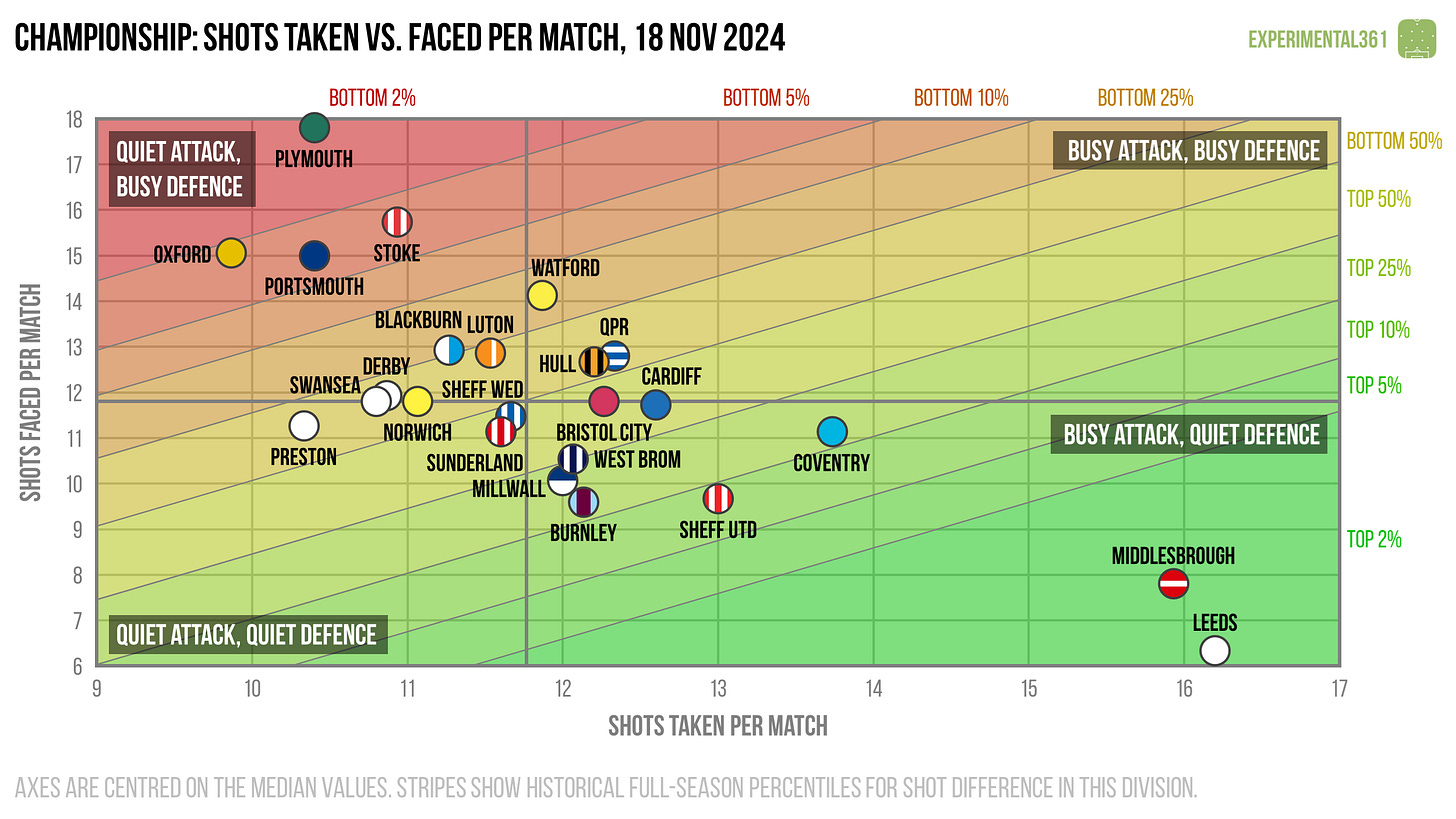Championship scatter graphics - November 2024
Revisiting another classic visualisation
Subscribers and followers who are already familiar with my work pre-Substack will no doubt recognise these graphics, which are probably the ones I’m best known for.
For anyone who is seeing them for the first time, they are explained fully in this post but I will briefly recap some of that information here.
In a nutshell, there are four different graphics that compare different pairs of attacking and defensive numbers for all of the teams in the division.
Shot dominance
First of all, here is how the number of shots taken by each club compares with those they face in return. The average number of shots taken per match is on the horizontal and the average number faced is on the vertical, so bottom right (take plenty, allow few in return) is good while top left (take few, allow plenty) is bad.
The stripes are like contours: the greener the stripe, the better the performance (and vice versa for red). The matching labels that sit around the edges of the chart indicate how good (or bad) it is to be in each shaded area, based on the historical distribution of teams over previous seasons.
Middlesbrough and Leeds are way out in front of everyone else here - they are both creating around 16 chances per match, which is four more than the league average.
Interestingly current leaders Sunderland are in the middle of the pack, creating and allowing a relatively average number of chances despite having one of the best goal differences in the division.
Struggling Cardiff also stand out here: they’ve out-created their opponents overall but are currently mired in 22nd place.
Attacking effectiveness
Now let’s look at attacking alone. The horizontal axis stays the same as in the graphic above, but now the vertical shows the average number of shots needed to score each league goal. Therefore bottom right is good (taking lots of shots and needing fewer efforts to convert) and top left is bad.
While Middlesbrough and Leeds are creating a lot of chances their conversion rate has been fairly pedestrian.
Sunderland meanwhile can thank the division’s most clinical attack for their impressive goalscoring rate. This could be a case of quality over quantity but it’s also possible that they’ve enjoyed an unsustainable hot streak in front of goal.
QPR currently sit rock bottom despite carving out opportunities at a respectable rate; their finishing has been letting them down.
Defensive effectiveness
Next let’s look at the defensive situation – basically take the above chart and replace the word “taken” for “faced” on both axes. Now top left is good (facing fewer shots and soaking up more for each goal conceded) and bottom right is bad.
There are a few eye-opening defensive records in the Championship right now, with Burnley and Sheffield United both unusually resilient so far this season. I wouldn’t expect those ratios of 20+ shots faced for each goal conceded to be sustainable over a whole campaign, but both teams are also allowing relatively few chances so shouldn’t collapse completely.
Plymouth have been the division’s punching bag with almost 18 shots faced per game, but the Pilgrims’ defence has been above-average at soaking up attacks.
Expected goals
Finally here's a version of the first graphic that uses expected goals (xG) instead of shots, which should be a more accurate reflection of attacking and defensive quality. These are calculated using my own somewhat ancient model based on a relatively simple dataset, but in practice it tends to agree pretty well with the more advanced ones out there.
When we adjust for shot quality both Leeds and Middlesbrough appear to be underachieving right now, particularly as the latter are performing at the level of an automatic promotion challenger but sitting seventh.
Both QPR and Cardiff look capable of climbing clear of danger on this evidence, assuming that their forwards overcome their goal-shyness.
Burnley appear to be taking a safety-first approach to their promotion challenge, operating one of the least potent attacks but also one of the toughest defences.







Superb stuff Ben.